The "LNG2Hydrogen" project works on the possible conversion of LNG terminals for use with hydrogen-based energy carriers. The current conditions are analyzed and the necessary technical and legal adjustments are identified. In addition, the technical and logistical challenges of onward transportation within Germany are analyzed. | Duration: 06/2023 - 11/2024
more infoResearch Projects
-
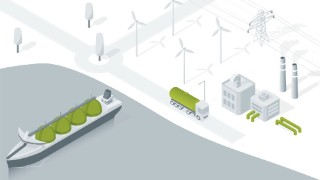
Conversion of LNG terminals into future-proof logistics hubs for hydrogen and its derivatives.
-

Schematic of a carbon-coated, heatable catalyst carrier with the possibility of direct heat input.
In the “AmmoCatCoat” research project, Fraunhofer ISE is working with partners from industry and research to investigate catalysts with novel biomass-based carbons as a ruthenium carrier material for more efficient, sustainable and cost-effective hydrogen production from ammonia. The activity of catalysts is evaluated particularly at low process temperatures. At the same time, the carbon materials are being adapted so that conventional coating methods can be used in order to be able to utilise electrically heatable catalyst carriers in the future. | Duration: 05/2024 - 04/2027
more info -
Attract: Flex-C-Cat II
Sustainable Carbon Supports for Hydrogenation Catalysis and their Characterization by Near Ambient Pressure X-ray Photoelectron Spectroscopy (NAP-XPS)
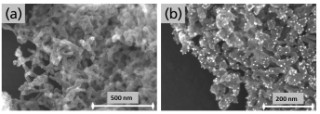
STEM nitrogen doped carbon NDC support (a), and Pd/NDC catalyst (b).
The Flex-C-Cat project contributes to the Power to Liquid process chain for sustainable hydrogen production and utilization. Heterogeneous catalysts play an integral role to produce fuels and chemicals in the present and the future. Therefore high performance and efficient catalysts need to be developed and shifted from petroleum to CO2 and bio-based feedstocks. In this context, the Flex-C-Cat II project focuses on the optimization and the characterization of biomass-derived mesoporous carbons as tunable heterogeneous supports for hydrogenation catalysis. The applicability of Flex-C-Cat catalysts will be demonstrated using several exemplary hydrogenations, relevant to both current and evolving industrial practice accompanied by Near-Ambient Pressure X-ray Photoelectron Spectroscopy investigation of these catalysts. | Duration: 06/2019 - 06/2021
more info -
Carbon2Chem® Phase 2
Subproject L-II: Dynamic Methanol Synthesis from Steel Mill Gases
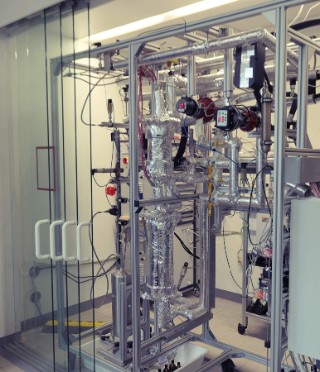
Fraunhofer ISE’s methanol miniplant during the long-term tests at the technical center in Duisburg.
German steel mills are responsible for around 6% of Germany's CO2 emissions. Combined under the generic term "steel mill gases", large quantities of process gases rich in hydrogen and carbon oxides (CO2 and CO) are produced in various sub-steps of steelmaking. Currently, steel mill gases are mainly used thermally, i.e. to generate electricity and heat. In the BMBF-funded Carbon2Chem® project, partners from industry and research are investigating various scenarios for using these steel mill gases as materials and closing the carbon cycle. In the subproject L-II, Fraunhofer ISE is investigating methanol synthesis from steel mill gases. This serves to demonstrate two essential building blocks of the energy system transformation: reduction of emissions and sector coupling. | Duration: 06/2020 - 05/2024
more info -
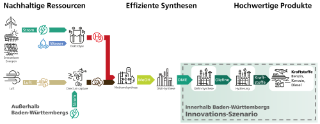
Value chain in the innovation scenario: hydrogen and CO2 are used to produce sustainable fuels.
In the “E-Fuels for the LÄND” project, three scenarios for the production of sustainable fuels for aircraft and vehicles are being examined in detail as part of a feasibility study, taking into account maximum value creation in Baden-Württemberg, resilient business models and a rapid market ramp-up. | Duration: 12/2024 - 11/2025
more info -
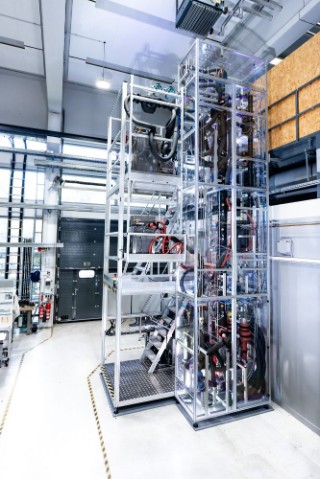
PN50 distillation column with a total height of 7.5 meters. The column can be operated both under vacuum and up to 40 bar overpressure.
The cost-effective and efficient global trade of green hydrogen, stored e. g. in the form of dimethyl ether (DME), lays the foundation for the defossilization of the industry. The “EARTH2” (Efficient And Resource-saving Transport of Hydrogen using Dimethyl Ether) project aims to industrialize an innovative and efficient chemical process for the production of the hydrogen carrier DME. The novel process using reactive distillation, in which the thermodynamic reaction equilibrium is bypassed by coupling synthesis and distillation, reduces energy requirements, plant complexity and investment costs. Funded by the Fraunhofer Future Foundation, the process for DME production is to be brought into industrial application. | Duration: 07/2024 - 12/2025
more info -

The global hydrogen potential atlas comprehensively identifies Germany’s possible partner countries.
The "HYPAT" project,is developing a global hydrogen potential atlas. For the first time, Germany's potential partner countries for a cooperative green hydrogen economy, including the most suitable production regions for a safe, economical and ecologically sustainable supply, are being comprehensively identified. | Duration: 03/2021 - 08/2024
more info -
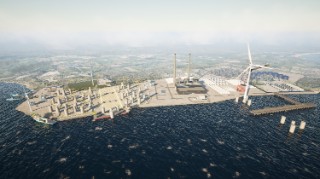
Green hydrogen and its derivatives are essential for the defossilization of mobility and industry. The HYreland project is identifying and evaluating promising locations for the production and export of hydrogen and hydrogen derivatives in Ireland.
The "HYreland" project investigates the technological, economic, and environmental potential for the production of green hydrogen and its synthesis products in Ireland, taking into account their transport to Germany. The project partners analyze two sites for their economic feasibility and cost reduction potential. In addition, Ireland will be compared with other hydrogen producing countries. The project also examines the greenhouse gas efficiency of the hydrogen supply chains and assesses the suitability of the analyzed products according to the Renewable Energy Directive (RED) of the European Union. | Duration: 11/2024 - 10/2025
more info -
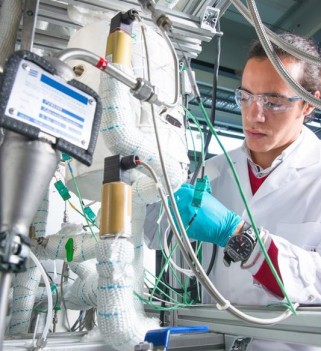
Fraunhofer ISE Mini-plant for methanol production from CO2 and H2.
Project in the Business Area Hydrogen Technologies and Electrical Energie Storage; Topic: Thermochemical Processes; Duration: January 2015 - September 2018
more info -
Hydrogen Hub TrHyhub
Trilateral Hydrogen Innovation and Export Hub between Western Australia, the Netherlands and Germany

With REPowerEU, the European Union (EU) has set itself the goal of importing ten million tons of renewable hydrogen from neighbouring countries and overseas by 2030 in order to replace fossil fuels in all sectors in Europe. Achieving this goal will require joint efforts by the member states and reliable partner countries. To this end, Germany and Australia had previously looked into the possibility of importing renewable hydrogen from Australia as part of the »HySupply« project funded by the German Federal Ministry of Education and Research (BMBF). The study »Site-specific, Comparative Analysis for Suitable Power-to-X Pathways and Products in Developing and Emerging Countries« by Fraunhofer ISE on behalf of the H2Global Foundation also concludes that Western Australia has a unique combination of great potential for renewable energy, low hydrogen production costs, high land availability and political stability. | Duration: 06/2023 - 05/2024
more info